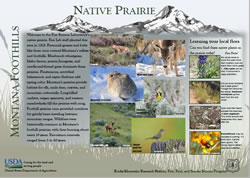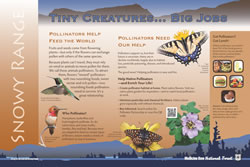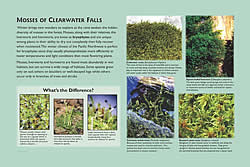Interpretive Panels
Our Forest Service Regions and our many partners have developed numerous and varied interpretive signs and posters about native plants, plant communities, ethnobotany, pollinators, and more. These images and interpretation help us to tell our story, to inform and to engage the public and are available to all who may find them useful.
Creating Pollinator & Native Plant Gardens
The Little Things Run the World
“Every time you walk into your garden to enjoy a beautiful flower or pick a fruit, you might thank a bee, butterfly, or hummingbird.”
There are two versions of this panel, one for Western United States species and the other for Eastern United States species.
See the artist's website for information about obtaining this panel for your garden: Nancy Seiler, "Native Plants & Pollinators".
Monarch Waystation
“During the breeding season, monarchs require milkweed plants upon which to rear larvae and nectar sources to sustain the adults during reproduction. Nectar sources are also required by the butterflies to fuel the fall migration to Mexico as well as the spring flights northward. Overwintering monarchs require shelter and water.”
The Wonder of Monarch Migration
“Monarch butterflies travel all the way from Mexico to Wisconsin every summer. This journey may take 3 or 4 generations. They come here seeking the native Common and Swamp Milkweeds, on which they feed, grow, and thrive.”
Native Prairie
“Welcome to the Fire Science Laboratory’s native prairie. Fire Lab staff planted this area in 2010. Perennial grasses and forbs like these once covered Montana’s valleys and foothills. Bluebunch wheatgrass, Idaho fescue, prairie Junegrass, and needle-and-thread grass dominate these prairies. Penstemons, arrowleaf balsamroot, and aspen fleabane add spring color.”
Pollinator Friendly Practices
Tips for planting a pollinator friendly garden.
Pollinator & Native Plants
Why "Bee" concerned about Pollinators?
“Native Plants and Pollinators go hand-in-hand. Michigan butterflies, moths, bees, hummingbirds, and other insects rely upon native nectar and host plants.”
Pollinator - Plants - People, A Partnership for Life
Descriptions of pollinators and their interrelationships with plants and people.
From the Chequamegon-Nicolet National Forest, Wisconsin
What's Buzzing at Boulder Lake Campground?
Chequamegon-Nicolet National Forest Native Plant and Pollinator Garden
“Bee” Inspired
Go Wild - Landscape with Native Plants
What's Buzzing at Laona Ranger Station?
Chequamegon-Nicolet National Forest Native Plant and Pollinator Garden
“Bee” Inspired
Go Wild - Landscape with Native Plants
An Old Friend Returns
“American elm trees were once a very important part of our lowland forests. They also lined city streets and created a graceful canopy over roadways. These remarkable trees could live over 200 years and grew so large that several people joining hands could not reach around them. Today, it is hard to find an Aemerican elm that is larger than fine inches in diameter.”
Susan Nelson of the USDA Forest Service Chequamegon-Nicolet National Forest, consulting with Linda Haugen, Plant Pathologist, Northeastern Area, and Dr. Jim Slavicek, Elm Project Leader, State & Private Forestry developed this panel.
Welcome to Our Gardens!
Northern Great Lakes Visitor Center Native Plant and Pollinator Gardens
“Bee” Inspired
Go Wild - Landscape with Native Plants
Battle for the Landscape
Microscopic Clues to the Past
Northern Great Lakes Visitor Center
Plants move in at the end of the Ice Age.
Swamp Survivor
Northern Great Lakes Visitor Center
The tree that breathes underwater.
From the Deschutes and Mt. Hood National Forests, Washington
Rugged Survivors…In Serious Decline
“Whitebark Pine has one good friend and several really bad enemies…”
From the Green Mountain & Finger Lakes National Forests, Vermont
Manchester Native Plant Garden
“The species of native plants you see here have been growing in this region since before European settlers arrived. Native plants are important habitat for wildlife, providing food and shelter.”
Native Plant Garden
What Can I See Here?
“Native plants are important because they have aesthetic, recreational, biological, medicinal, economic, and conservation value. What can you find in the garden that fits one of these categories?”
Rain Barrel
What is a rain barrel?
“A rain barrel collects and stores rainwater for you until you are ready to use it in your garden. It can save you money on your water and electric bills. It is also a good way to store water for dry periods.”
Wildflower Garden
“Native plants are important because they have aesthetic, recreational, biological, medicinal, economic and conservation value.”
Wildflower Garden
“Native plants are important because they have aesthetic, recreational, biological, medicinal, economic and conservation value.”
From the Hiawatha National Forest, Michigan
Aquatic Invasives in the Great Lakes Region
Aquatic invasive species in the Great Lakes Region include both plants and animals, which are mostly spread through human activities such as boating and fishing. Once introduced to bodies of water these species proliferate, disrupting the food chain and damaging native fish populations.
From the Hoosier National Forest, Indiana
Early Successional Habitat Area - Haskins Tract
Improving Habitat with Pollinator Areas
Early Successional Habitat Area - Mifflin Tract
Combining Prescribed Fire with Native Plants
Early Successional Habitat Area - Pollinator Fields
Improving Habitat with Native Plants
From the Medicine Bow National Forest, Wyoming
Snowy Range Tiny Creatures… Big Jobs
Pollinators Help Feed the World
”Fruits and seeds come from flowering plants—but only if the flowers can exchange pollen with others of the same species. Because plants can’t travel, they must rely on wind or animals to move pollen for them. We call these animals pollinators. To attract them, flowers “reward” pollinators with two nourishing foods; sweet nectar and rich pollen—two nourishing foods pollinators need to survive. It’s a great relationship.”
Snowy Range What's the Buzz?
Hardworking Native Bees are All Around Us!
”Most people don’t realize it, but native bees are everywhere—in all shapes, sizes, and colors. Some hardly look like bees at all!”
From the Monongahela National Forest, West Virginia
What's Buzzing at Stuart Recreation Area
Monongahela National Forest Pollinator Garden
”Native Plants and Pollinators go hand-in-hand. West Virginia butterflies, moths, bees, hummingbirds, and other insects transfer pollen between plants, assisting plants with reproduction.”
From the Nebraska National Forests and Grasslands, Nebraska
Blowout Penstemon
Even the toughest customer needs a little help now and then…
”Sand dunes can be very hot or cold, dry and windy - a pretty tough place for most plants to thrive.”
From the Okanogan-Wenatchee National Forests, Washington
Tiffany Botanical Area
"Tiffany Mountain is a panoramic setting for unfolding change. Glaciers shaped this landscape over 10,000 years ago, carving the north-facing cirques, and hollowing out the depression now filled by Tiffany Lake. Ice flowed around, between, and over many of the surrounding peaks, but Tiffany may be a 'nunatak,' a geological term describing a mountain peak that protruded above an ice sheet."
From the Ottawa National Forest, Michigan
Native Plant Gardens on the Ottawa National Forest
"Visit one to see how native plants can be used in landscaping and gardening!"
Ottawa National Forest Rain Garden
“This rain garden is designed to hold stormwater runoff from roofs and pavement of the administrative buildings across the road. Water is collected and piped into the garden on the east side. This garden slows the flow and allows water to infiltrate into the soil. Wetland plants and soil filter the runoff, removing pollutants such as oil and fluids leaded from cars in the parking lots.”
Stop the Spread: Clean your Tread!
“Non-native invasive species threaten the health and sustainability of our North Woods: help stop the spread!
Please use the bicycle cleaning station before your ride…”
From the Rogue River-Siskiyou National Forest, Oregon
Iron Mountain Botanical Area
“Its in the soil At 4,000 feet elevation, Iron Mountain is one of the tallest mountains in the coast range. Geologically, it is composed of great intrusive masses of granitic rocks bordered by metamorphics such as serpentine, slate, and marble.
Two worlds meet Plants from the northern range (Oregon and Washington) overlap with plants from the southern range (California)…”
From the Shasta-Trinity National Forest, California
Black Oak Woodlands, Bread Basket of The People
”Black oak (Quercus kellogii) is a tree revered by the native people of northern California. The flavorful, oil-rich acorns of this oak are preferred over other oak species as food because of their superior taste and the pudding-like texture of the cooked meal.”
Fading Gold, Quaking Aspen in Our Forests
”In the mountains of northern California, deciduous aspen groves are oases of plant and animal diversity in a vast sea of shady conifer forest. Abundant sunlight, moisture and occasional wildfire or other disturbance keep aspen groves vigorous and the understory rich with a diversity of grasses, wildflowers, and shrubs.”
Klamath-Siskiyou Serpentines Ancient Refuge for Rare Plants
”The Klamath-Siskiyou Mountains of northwest California and southwest Oregon are the largest body of serpentine type rock in North America. This challenging and unusual substrate, coupled with the ruggedness, isolation, and great age of these mountains, gave rise to a spectacular flora that is peculiar to this corner of the world.”
A Parade of Pollinators, Follow the Sun
”Sunny openings in our forests are hotspots for wildflowers and flowering shrubs that provide food for pollinators. In exchange, the pollinators (bees, butterflies, birds, bats, beetles, moths, wasps, and ants) provide the pollen-moving labor necessary to make seeds and fruits. People reap the benefits too because without pollination, much of the food we eat would never come to be.”
Welcome to the Shasta-McCloud Native Plant Interpretive Garden!
”This garden, greenhouse and nursery are all part of the Shasta-Trinity National Forest's restoration program.”
From the Tongass National Forest, Alaska
A Slow Struggle to Reclaim Barren Land
”The spot you are standing on was first exposed by the retreating glacier around 1950. It has taken pioneering and colonizing plants nearly a half century to get a foothold on the barren glacial outwash. In fact, it will take over two hundred years to establish forest similar to the one you see on the upper slopes of Mendenhall Valley.”
The panel above and the the set of signs below of southeast Alaska plants are on display at the Mendenhall Glacier Visitor Center in Alaska. They are located in prominent locations at the visitor center area, along its trails, and are seen by thousands of people.
From the Umpqua National Forest, Oregon
Mosses of Clearwater Falls
”Winter brings new wonders to explore as the rains awaken the hidden diversity of mosses in the forest. Mosses, along with their relatives, the liverworts and hornworts, are know as bryophytes and are unique among plants on their ability to dry out completely, then fully recover when moistened. The winter climate of the Pacific Northwest is perfect for bryophytes since they usually photosynthesize more efficiently at lower temperatures and light conditions than most flowering plants.”
From the Wayne National Forest, Ohio
The Importance of Pollinators
”What is a pollinator? Insects (bees, wasps, moths, butterflies, flies, beetles) are the most common pollinators, but as many as 1,500 species of vertebrates such as birds and mammals serve as pollinators also.”
Landscaping with Native Plants
“Native wildflowers, ferns, grasses, shrubs, and trees are a stunning part of our local heritage. These native plants provide year-round beauty and interest to our gardens. In addition they are an environmentally friendly choice for landscaping and restoration.”
Native Plant Rescue
“What is a plant rescue? It is an opportunity for individuals to salvage native plants from the future construction sites.”
Wayne National Forest Native Pollinator Garden
This is a collection of 19 panels describing native plant species, their pollinators, and habitat.
Prairies of Ohio
“What is a prairie? Why are prairies important? Prairies on the Wayne National Forest ”
Download panels (PDF, 4.7 MB)…
The PDF file includes two slightly different versions of the same panel.
Vernal Pools in Ohio
“Vernal pools derive their name from the Latin "vernus", meaning "belonging to spring". The vernal pool is composed of either bedrock or a hard clay layer in the soil that helps keep water in the pool. These seasonal wetlands periodically dry up and do not contain fish. This creates a safe habitat for frogs, toads and salamanders to mate and lay eggs.”
What's Buzzin' on the Wayne?
“Many of the plants in the gardens around this office are native to the southeastern Ohio region. Gardening with native plants is an important step to protect and promote populations of pollinator species. Take a walk and learn more about our native plants and their pollinators.”
From the Willamette National Forest, Washington
The Evolution of Floral Diversity
“Over 300 species of flowering plants call Iron Mountain home. Its unique geologic history and location create a variety of soil types and microclimates that allow for greater plant diversity.”

























































